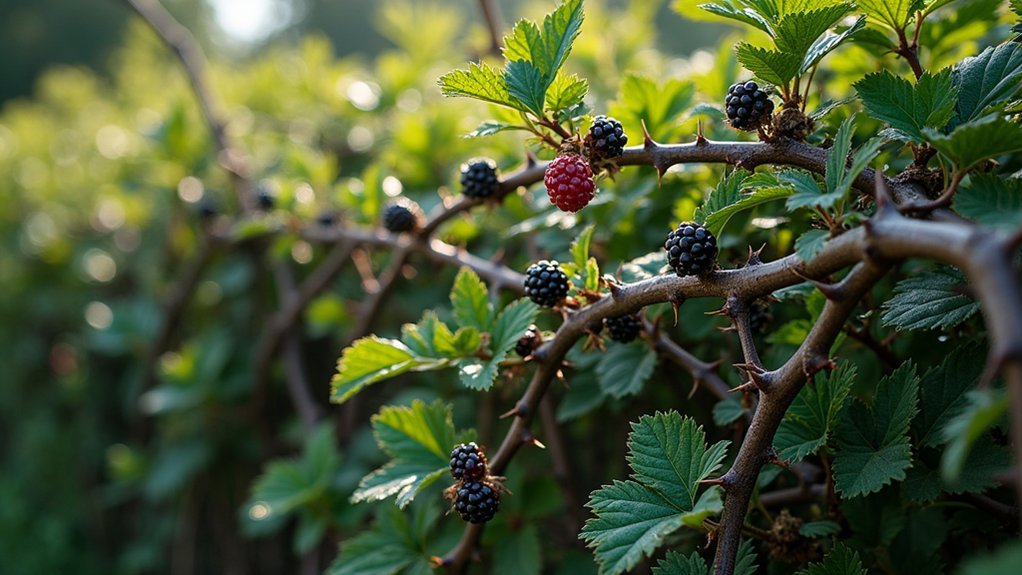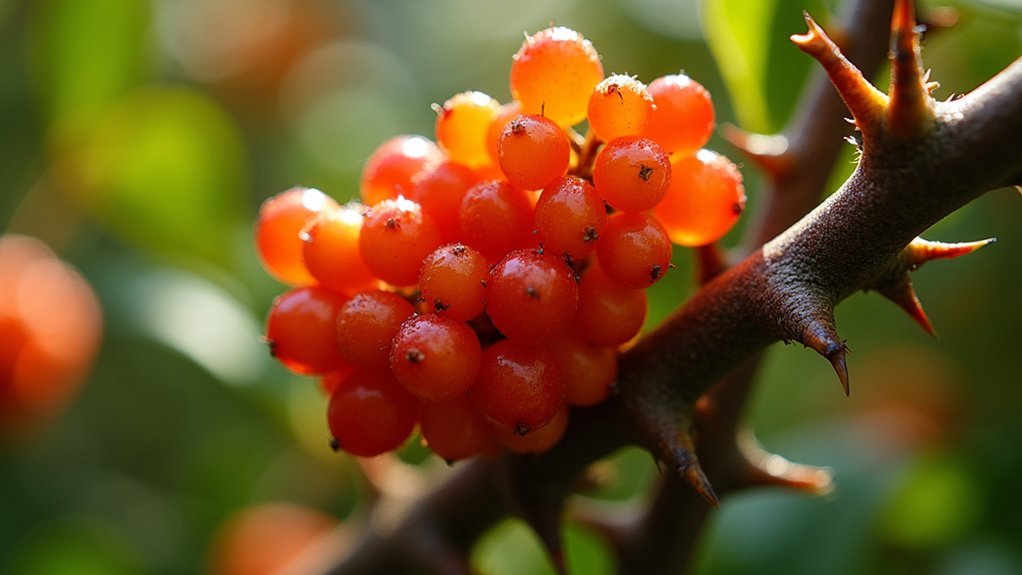For effective deer-proof natural fencing, consider these five thorny barriers: Blackberry creates dense, fruiting walls up to 10 feet tall; Native Barberry offers ecological benefits with four-season interest; Pyracantha combines sharp thorns with vibrant berries; Osage Orange provides traditional impenetrable barriers with strategic pruning; and Rosa Rugosa thrives in coastal conditions with aggressive growth habits. Each option balances defensive properties with aesthetic appeal while requiring minimal maintenance once established. Discover which thorny defender best suits your landscape needs.
Blackberry: Creating Impenetrable Natural Barriers

Five key attributes make blackberry hedges exceptional deer deterrents. Their rapid growth and thorny canes form physical barriers up to 10 feet tall, while producing fruit that distracts deer from other garden plants.
The dense network of stems creates an opaque wall that limits visibility and access. You’ll appreciate their adaptability to poor soils and minimal water requirements once established.
Blackberry hedges form impenetrable natural screens while thriving in challenging conditions most landscaping plants would reject.
For maximum effectiveness, pair young blackberry hedges with temporary chain-link fencing until they mature. Growing wild blackberry vines as a natural barrier aligns with effective planting strategies.
Remember to control their spread by mowing perimeter shoots annually and removing dead canes in summer. Pinch new growth after fruiting to encourage side branching and density.
While establishing your living fence requires some patience, you’ll gain both an effective barrier and ecological benefits that synthetic fencing can’t provide.
Native Barberry: Thorny Protection With Seasonal Beauty
Unlike its invasive cousins, native barberry offers thorny protection while supporting local ecosystems.
You’ll recognize these New England natives by their simple, alternate leaves with finely serrated edges and distinctive 3-parted spines along reddish-brown stems.
Native barberry thrives in forest edges and meadows, preferring well-drained soils and partial sun exposure.
Their dense growth habit and vicious spines create effective deer barriers while providing four-season interest – spring’s yellow blooms attract pollinators, summer’s juicy berries develop into brilliant fall foliage, and winter reveals architectural structure with persistent berries. Early American settlers valued these plants for creating hedgerow barriers and producing yellow dye and jam.
With slow growth of 10-20cm yearly and mature heights of 1-3m, these low-maintenance shrubs require minimal care.
Choose North American B. canadensis over European B. vulgaris to avoid wheat rust concerns.
Pyracantha (Firethorn): Stunning Berries With Defensive Spines

Pyracantha earns its “firethorn” nickname honestly, combining spectacular berry displays with formidable defensive capabilities. This evergreen shrub from the Rosaceae family grows 10-15 feet high and wide, making it perfect for creating impenetrable barriers.
You’ll appreciate its year-round appeal – glossy dark green foliage, clusters of white spring flowers, and vibrant orange-red berries that persist through winter. The sharp thorns effectively deter deer while providing shelter for birds that feast on its colorful fruits. Its excellent erosion control properties make it an ideal choice for planting on slopes where soil stabilization is needed.
Plant pyracantha in full sun to partial shade in well-drained soil. It’s remarkably adaptable to various conditions, including clay, alkaline, and occasionally dry soils.
Consider training it as an espalier against walls or fences for a stunning architectural element. Regular pruning helps maintain its shape and control its vigorous growth.
Osage Orange: Traditional Livestock and Deer Deterrent
Farmers across America’s heartland have long relied on Osage orange (Maclura pomifera) as an impenetrable living fence.
Before barbed wire’s 1874 invention, these thorny hedgerows served as natural livestock containment, with Native Americans previously using the dense wood for bows.
You’ll recognize Osage orange by its distinctive green “hedge apples” and formidable half-inch thorns that effectively prevent deer passage.
The dense branching eliminates safe landing zones for jumping deer, while the thorny structure creates a physical barrier they won’t attempt to breach.
This hardy species thrives in zones 4-9, tolerating drought and poor soils while growing 2-3 feet annually.
With regular strategic pruning, you can maintain a manageable height while encouraging the lateral growth needed for an effective barrier.
However, be prepared to manage its vigorous spreading tendency and wear protective gear when pruning to avoid painful thorn punctures.
Rosa Rugosa: Salt-Tolerant Coastal Thorny Hedge

Renowned for its resilience in harsh coastal environments, Rosa rugosa creates a magnificent thorny barrier that deer consistently avoid. This robust shrub grows 4-6 feet tall, forming dense thickets covered with sharp prickles that effectively deter browsing wildlife.
You’ll appreciate its adaptability to sandy, salty soils where few other roses survive. Its aggressive suckering habit quickly fills gaps, preventing deer from finding entry points. The shrub has become naturalized in nineteen states across the northeast and central United States.
The fragrant pink blooms from late spring through summer transform into persistent red hips that attract birds without compromising the hedge’s defensive structure.
Plant Rosa rugosa in full sun to partial shade, where it requires minimal maintenance. Its moderate growth rate of 20-40 cm annually means you’ll establish an effective barrier within a few seasons, while its natural disease resistance guarantees long-term performance with little intervention.
Frequently Asked Questions
How Soon After Planting Will Thorny Hedges Effectively Deter Deer?
You’ll need patience—thorny hedges won’t deter deer immediately. They’ll start providing basic protection after 2-3 years, but won’t form a truly effective barrier until they’ve matured for 4-5 years.
Can Thorny Hedges Damage or Harm Passing Wildlife?
Yes, thorny hedges can harm wildlife through physical injuries, entrapment, and creating migration barriers. However, you’ll find they also provide shelter, food sources, and habitat benefits when properly designed with wildlife gaps.
What Maintenance Prevents Thorny Hedges From Becoming Invasive?
To prevent thorny hedges from becoming invasive, you’ll need regular pruning to control spread, mulching to suppress volunteer seedlings, proper spacing between plants, and installing root barriers. Don’t forget to remove invasive shoots promptly.
Are Thorny Hedges Effective in Heavy Snow Regions?
In heavy snow regions, you’ll find thorny hedges can struggle. They’ll need supports like trellises to prevent breakage. Choose flexible-branched species and clear snow regularly to maintain their structural integrity.
How Do You Create Gaps for Human Access Through Thorny Hedges?
To create gaps for human access through thorny hedges, you’ll need to install gates, wooden sections, or pathways during initial design. Maintain clear openings with regular pruning and consider protective barriers like mesh screens.
In Summary
You’ve now discovered five exceptional thorny hedge options that’ll create natural, deer-resistant boundaries around your property. Whether you choose the fruit-bearing blackberry, the colorful barberry, the vibrant pyracantha, the traditional osage orange, or the coastal-friendly rosa rugosa, you’ll enjoy both beauty and protection. Plant them properly, provide appropriate care, and you’ll soon have a living fence that keeps unwanted visitors out while enhancing your landscape.





Leave a Reply